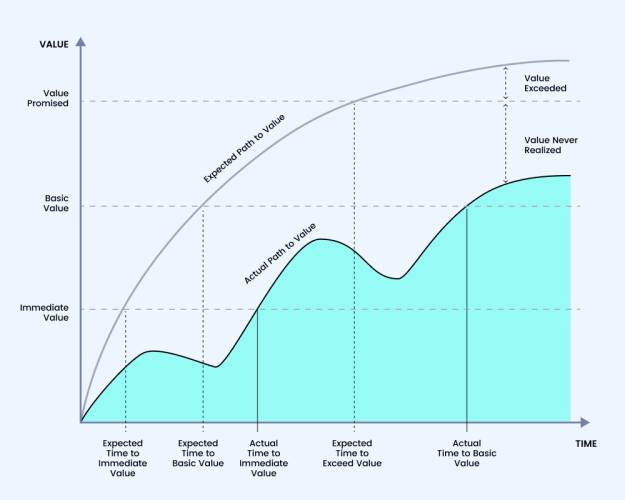 Edwin Halim
Edwin Halim
Sep 17, 2020
 Edwin Halim
Edwin Halim
Sep 17, 2020
eCommerce is a highly metrics-driven industry. Marketers take into account a host of KPIs before investing in a tool: ROI, ROAS, Customer Acquisition cost, Conversion rate, Retention rate, Bounce rate, Lifetime Value … the list is long. These are all tangible metrics that provide marketers with an accurate picture of how a tool will fare in the marketing world. However, there is one intangible metric that acts as a common denominator for all the tangible ones: Time.
Time is money in today’s highly-competitive eCommerce market, as customers want to see a return on investment in the shortest time after making a purchase. If it doesn’t happen, they might churn. This makes Time to Value (TTV) a critical intangible metric. TTV is the time a new customer takes to gain value from a product. With this metric, marketers measure the duration time to success. If you are the Head of Digital of an eCommerce company, you would prefer 1.5 times improvement in overall conversion rates in 3 months’ time over a 3 times improvement in 2 years. If you are the CMO, you would want to show 2x ROI from marketing spend in 6 months’ and not in 2 years time! The shorter, the better.
Time To Value in Marketing
Measuring Time To Value
The Bumpy Road To Faster Time to Value
Challenges in Optimizing TTV
Choosing A Marketing Platform With Faster Time To Value
In simple terms, TTV is the time it takes to see the results following a specific action.
The primary value that marketing tools provide is to increase revenue. Every activity that the tool performs—be it releasing a new product, onboarding multiple channels, launching a new ad campaign, or automating marketing activities—are aimed at increasing profits, after an expected time lag. This lead time is defined as Time to Value in Marketing (TTVM). For a MarTech tool to be effective, the time between purchasing a tool and results coming from it should be minimal (faster TTVM).
TTVM is the time gap between purchasing a marketing product and when the product begins yielding results. TTVM has become a critical metric for choosing the right marketing tech for eCommerce businesses. Marketers prefer tools that minimize TTV, giving the best results in the shortest possible time.
Being an intangible metric, measuring TTV can be mathematically complicated. One, the method to calculate the metric varies, depending on your product, service, or business model. Two, there are different phases of measuring the TTV of a marketing technology product. These are:
Phase #1: Time to Immediate Value
This is the time a product takes to show immediate delight. In layman terms, it’s a case of instant gratification – you buy ice cream and immediately savor it. Example: the time you take to trial and integrate a marketing technology solution.
Phase #2: Time to Basic Value
This is the time when your solution starts delivering the minimum value promised. However, your customer has yet to realize its value on a larger scale. For marketing tools, it is when you customize a tool for usage and start running campaigns that deliver primary results.
Phase #3: Time to Exceeded Value
This is the time when the larger values start becoming visible. This is the time when a tool’s value has exceeded a customer’s expectations, prompting them to continue doing business with you. At this stage, the customer is accustomed to the tool, has tested most of its key features, and is running advanced personalization campaigns that are delivering results as per pre-defined metrics.
Phase #4: Time to Longer Value
This is the time when a customer realizes the full potential of a platform. Going forward, they invest further in the solution – in terms of new advanced features, integration with other tech-stacks, creating automated workflows, and investing more resources to manage the solution.
A marketing solution should be capable of minimizing the time to reach each of these four stages of value-creation.
We’ve understood TTV and its different phases. The next step is to find the right marketing tech stack that ensures the fastest time to value for marketers. Most MarTech platforms available in the market come with similar features and functionalities, promising fast time to value as well. But that’s not always the case. If we plot the promised path to value vs the real journey, we usually end up with a bumpy picture.

Let’s consider a possible scenario with a MarTech solution: if the Time to Immediate and Time to Basic Value were to come at a very late stage, then the pressure for the tool to perform would have already started building by the time the tool enters its later operational stages. It may also be possible that these promised values are not delivered at all. This is the primary reason why marketing teams end up getting disappointed with a product.
Before going shopping for a right-fit MarTech tool, it’s important for marketers to understand the factors that affect TTV and analyze some of these challenges.
The time taken to integrate your marketing tool is one of the most important factors in determining TTV. As you know, integrating a new marketing tool into your eCommerce system and marketing channels has various steps. You can face challenges in any or all of these steps and it’s important to evaluate your solution against each step.
Most marketing platforms integrate in two ways:
– Directly: using a javascript code placed in your digital properties.
– Indirectly: using tag managers.
Using javascript code can be complicated, with exclusion scenarios, and would need the support of IT at some point. To avoid IT delays and impact on your immediate TTV, go for a tool that supports your preferred tag manager.
Once the basic integration is completed, you will need to customize the tool as per your systems and requirements. This process needs to map your events and attributes in a way that the marketing software understands, and usually requires heavy engineering/IT effort. This affects basic TTV. Modern marketing platforms come with the ability to map business rules easily. A few even have automated business rules mapping. These help lower Time to Value.
Once your marketing software is customized, you have to ensure it has enough data to act upon. Most of this data will be stored in your product catalog and content management system. This data has to be mapped correctly so that it can be analyzed and processed efficiently- also called the data onboarding process. However, this process can take a lot of manual effort, in terms of creating unique XML or CSV feeds. If your marketing platform is unable to automate the data integration process, you will end up with a longer Time to Value.
We live in an omnichannel world, where a number of channels are used simultaneously for running marketing campaigns. Ensure that your marketing software works with your website, mobile web, app, email, SMS, and every other channel in your kitty. The solution should be able to integrate seamlessly with these channels, with ready to use connectors and APIs.
If you integrate and customize your marketing platform in a short period of time, you ensure faster Time to Basic Value. To get to the next step – Time to Longer Value – needs more than just tools, data, and channel integration. For this, the data needs to be trained, to help you perform actions. -Marketers might want to know what action their user will perform next or find out what user segment might churn. AI-powered platforms, that use complex machine learning algorithms, can predict future user behavior, giving marketers the foresight to act on these suggestions. Any tool that does not employ machine learning on its dataset will delay your TTV.
In order to derive value from a tool for a longer time period, you would need to act on the data intelligence on a continuous basis. Drawing a personalized roadmap to make maximum use of the software is critical. Investing in an after-sales service package, along with the software, can help marketers implement new ideas and scenarios. Failing to do this will delay the Time to Longer Value.
There are some specific capabilities to look for in a marketing platform that minimizes TTV:
Time to value is one of the most important factors to consider before making any marketing investment. The path, however, can be bumpy and unpredictable, if every factor isn’t carefully considered during the tool evaluation stage. Several challenges can crop up on the way to minimizing Time to Value. Marketers need to be mindful of these barriers and should look for specific features in their choice of a marketing platform to achieve faster TTV.
Insider’s AI-powered Growth Management Platform helps you to deliver impactful marketing experiences with the fastest time to value. Request your demo today.

Written by
Edwin Halim
Edwin is oversees Insider's customer success team in Indonesia and the Philippines. He has 6+ years of experience in digital marketing, with a special focus on multichannel CRM strategy, growth hacking, and A/B testing. Before Insider, Edwin was a technology consultant at Accenture and co-founded his own Digital Agency.